Antarctica

The rocks exposed in the Yorkshire Dales at Ingleborough and Penygent are sequences dominated by alternating layers of limestone, shale and sandstone. These rocks were laid down as the landmass passed through the equatorial zone in its long drift north from near the South Pole to the Northern Hemisphere. During this time, the sediments that now form these rocks were deposited in a vast delta environment in which the sea level fluctuated. These rocks are therefore records of the prevailing sea level changes during this period.
 |
|
| Ice loss through shedding icebergs: © NASA |
Today, the Antarctic ice sheet extends over 14 million square kilometres, roughly the area of the US and Mexico combined! If the entire ice sheet melted the resulting rise in global sea elvel would be more than 58 m. Studying ice sheets can help us learn about the Earth’s climate history and this is done through the extraction of ice cores which are drilled on the ice sheet. The gases dust and water molecules trapped in the buried ice provide a record past climates and environments. Some of the ice cores extracted extend to up to 3km in depth and the oldest continuous ice core records date back 800,000 years. Bubbles of air trapped in the ice contain samples of ancient atmospheres and this allows us to measure past concentrations of CO2 and methane, providing uniquely detailed information on past atmospheric chemistry and climates.
 |
|
| The British Antarctic Survey ship the James Clark Ross at Rothera Station, Antarctica © Tom L-C |
Ice sheet and glacier melting contributes significantly to changes in sea level. The British Antarctic Survey, the Centre for Polar Observation and Modelling as well as several UK universities carry out important work tracking the size and behaviour of Antarctica’s ice sheets by undertaking fieldwork on the ice sheets and also through satellite monitoring. Several major ice shelves in the Antarctic Peninsula region have collapsed in recent decades and this is being carefully monitored. Satellite monitoring has suggested that ice sheets are more sensitive to climate change than once thought, particularly in respect of rates of ice flow and the potential for runaway retreat. The Intergovernmental Panel on Climate Change recognizes that it is not possible to fully predict the ice sheets’ contribution to sea level change and this could be higher than the estimates they currently provide.
Further reading:
National Snow and Ice Data Center - Quick facts on ice sheets
Antarctica Glaciers - Calculating glacier ice volumes and sea level equivalents
Related Links
Other sites
- Twin: Windward Isles
Cwm Idwal
- Twin: Mount Pinatubo
Sperrin Mountains
- Twin: Sierra Nevada
Southern Uplands
- Twin: Nankai
Ben Arnaboll
- Twin: Glarus Thrust
Outer Isles
- Twin: Tohoku Earthquake
Clogherhead and Shannon
- Twin: Papua New Guinea
Cairngorms
- Twin: New Hampshire Granites
Great Glen Fault
- Twin: North Anatolian Fault
The Lizard
- Twin: Troodos Ophiolite
Yoredales
- Twin: Antarctica
Stanage Edge
- Twin: Ganges Delta
Hartland Quay
- Twin: Zagros Range
Amroth-Saundersfoot-Tenby
- Twin: Salt Range, Pakistan
Vale of Eden
- Twin: East African Rift Valley
Zechstein
- Twin: Sicily
Alderley Edge
- Twin: Navajo Sandstone
Isle of Skye
- Twin: Mount Kilimanjaro
Lulworth Cove
- Twin: Albania
Giant's Causeway
- Twin: Cascade du Ray Pic
